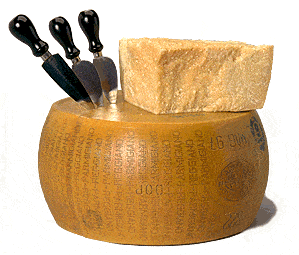Photo courtesy of Gastronomical Products of Parma
By Judy J. Pinegar
No cheese is as famous and essential to Italian cuisine as Parmigiano, therefore, no visit to the Emilia-Romagna region of Northern Italy is complete without exploring the making of Parmigiano-Reggiano Cheese . Parmigiano is the Italian adjective for Parma, while Reggiano is the adjective for Reggio Emelia, both cities and providences of the same name in the Emilia-Romagna administrative region.
Parmigiano-Reggiano is made from raw cow’s milk, 16 liters (4.2 gallons) of milk per kilo (2.2 pounds) of cheese, and the cows must be fed only on grass or hay. Adding a partly skimmed milk to whole milk, and using copper lined vats for heating and cooling, with additions of natural whey culture (starter), and calf rennet (enzymes from the stomach), the milk coagulates. It then separates into solids (curds) and liquid (whey). The compacted curd is collected in muslin for cheese making, and the remaining whey is fed to the pigs from which Parma Ham will be produced! In many farms in Emilia-Romagna, the barns for the pigs are just yards from the cheese producing rooms.
The cheese is put into a stainless steel round form, pulled tight by a buckle so the cheese retains a wheel shape, and then imprinted several times with the words Parmigiano-Reggiano, the plant number, month and year of production. After brining in salt water the approximate salinity of the Mediterranean Sea, for 25 days, the wheels are then aged for at least 12 months. At this point each and every cheese is inspected and graded by the Consorzio (Consortium) Parmigiano-Reggiano. The cheese is tested by a master grader whose only tools are a hammer and his ear. By tapping the wheel at various points, he can identify undesirable voids and cracks within the wheel. Those that pass the test get the Consorzio’s logo branded on their rinds while cheeses that do not make the grade are stripped of all markings.
More aging follows and some people think Parmigiano-Reggiano is best at 24 to 30 months when it is still soft and crumby, with tiny crunchy areas from the salt, yet rich and complex. The cheese has a sharp, complex fruity/nutty taste and a slightly gritty texture. Inferior cheeses can impart a bitter taste. The name is trademarked, and in Italy there is legal exclusive control exercised over the production and sale of Parmigiano-Reggiano, under a governmental decree.
The average Parmigiano-Reggiano wheel is about 18–24 centimeters (7.1–9.4 in) high, 40–45 centimeters (16–18 in) in diameter, and weighs 38 kilograms (84 lb).
Uses for Parmigiano-Reggiano include being grated over pasta, stirred into soup and risotto, and eaten in chunks with balsamic vinegar. It is also a key ingredient in Alfredo sauce and pesto. In Emilia-Romagna it is often paired with pears and walnuts and enjoyed as a dessert at the end of a meal.
Outside Europe, most notably in the United States, commercially produced imitator cheeses may be legally sold under the generic name “Parmesan.” Parmesan is the French-language name and also is the informal term for the cheese in the English language. The name Parmesan is also used for cheeses which imitate Parmigiano-Reggiano, with statements such as “Italian hard cheese” to skirt legal constraints. In North America parmesan cheese is only aged for 20 months, and the milk used is pasteurized, Parmigiano-Reggiano on average contains two-thirds less salt than the average Parmesan so be sure you get the real thing if you are a true Italiano!
Written by Judy J. Pinegar
World Traveler & Writer
Need articles written? You may contact Judy through me
John J. O’Dell
Real Estate Broker
O’Dell Realty
(530) 263-1091
Email John jodell@nevadacounty.com
DRE #00669941
